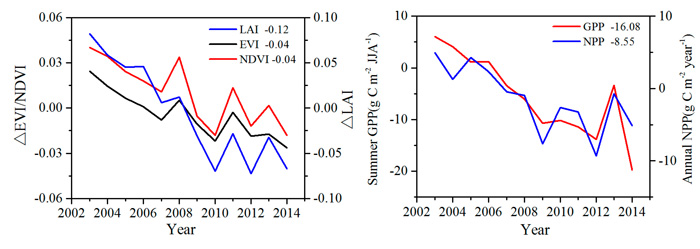| Follow @co2science |
Paper Reviewed
Tang, B., Wu, D., Zhao, X., Zhou, T., Zhao, W. and Wei, H. 2017. The observed impacts of wind farms on local vegetation growth in northern China. Remote Sensing 9: 332, doi:10.3390/rs9040332.
There are a number of legitimate reasons for opposing wind farms; (1) they kill birds, bats and other animals, (2) they create undesirable ambient noise, (3) they blight the landscape and (4) the power they generate is far more costly per kilowatt hour than that obtained from conventional fossil fuels. Now, however, thanks to the studious research of six Chinese scientists (Tang et al., 2017), we can add a fifth reason for avoiding wind farms -- they reduce the productivity of surrounding vegetation.
In reaching this conclusion, Tang et al. used remotely-sensed imaging data, including leaf area index (LAI), normalized difference vegetation index (NDVI), an enhanced vegetation index (EVI), gross primary production (GPP) and net primary production (NPP), coupled with other climate-related data (temperature, soil moisture, evapotranspiration, albedo and wind) over the period 2003-2014, to analyze the effects of a recently built wind farm on summer (Jun-Aug) vegetative growth in the Bashang region of northern China. Located in the Hebei province, the Bashang study area (40.9-41.5°N, 113.9-114.7°E) witnessed a total of 1747 wind turbines constructed between the period 2005 and 2011. Land cover in Bashang primarily consists of grassland and crops, which account for 53.4 and 44.7 percent, respectively, of the total cover. Thus, using the remotely-sensed and climate data described above, Tang et al. set out to determine whether the wind farm construction in Bashang exerted any influence on the growth and productivity of the region's summer vegetation.
And what did their analysis reveal?
In describing their findings, Tang et al. report that construction of the wind turbines elevated both day (by 0.45-0.65°C) and night (by 0.15-0.18°C) temperatures, which increase, they say, "suppressed soil moisture and enhanced water stress in the study area." As a result, local vegetative growth and productivity decreased (see Figure 1). More specifically, they calculated an approximate 14.5, 14.8 and 8.9 percent decrease in LAI, EVI and NDVI over the period of study, as well as "an inhibiting [wind farm] effect of 8.9% on summer GPP and 4.0% on annual NPP." Consequently, these several findings led Tang et al. to conclude that their research "provides significant observational evidence that wind farms can inhibit the growth and productivity of the underlying vegetation." And thus we have yet another reason to question the wisdom of policy makers who are seemingly rushing to install more and more of these bird-killing, noise-polluting, eyesore-viewing, cost-prohibiting and vegetative-decreasing low power producing energy sources. It doesn't make any sense, does it?

Figure 1. Inter-annual variations of area mean vegetation index differences (left panel) and GPP and NPP (right panel) differences between wind farm pixels and nearby non-wind farm pixels for the period 2003-2014. The insert numbers are the area mean VI, GPP, and NPP differences between the post- and pre-turbine construction periods (2012-2014 minus 2003-2005). Source: Tang et al. (2017).




